House of Vettii House of Vettii Ap Art History
Buried by a volcanic eruption ii m years ago, this Roman house was the epitome of wealth and mode.
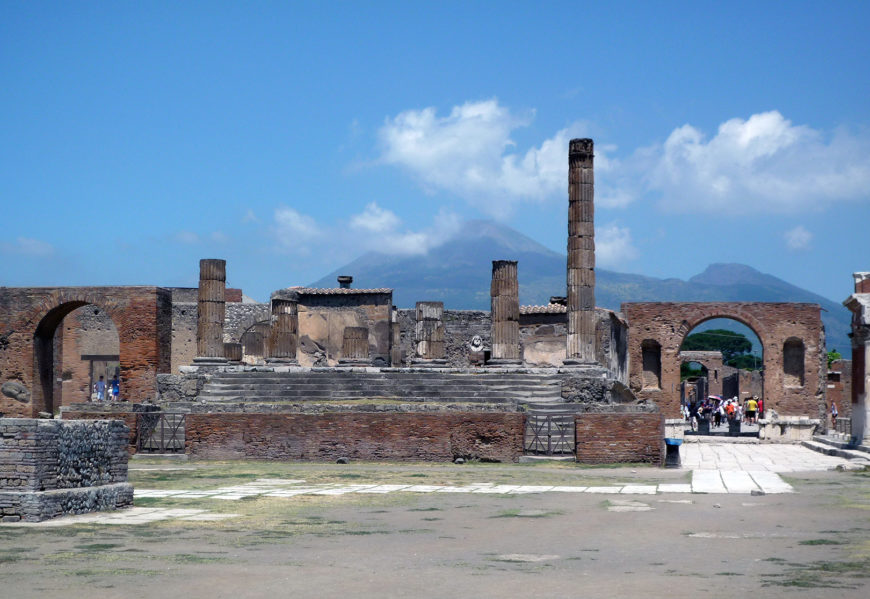
View of the Forum with Mountain Vesuvius in the distance, Pompeii (photo: Steven Zucker, CC BY-NC-SA ii.0)
The ancient city may be quiet now, its life ended by a fantastic cataclysm virtually two thousand years ago, just the remains of houses, decorations, and the objects of daily life whisper to us most the lives of the ancient people who inhabited Pompeii before the eruption of Mount Vesuvius. Domestic spaces, in particular, offer a rich resources for examining ancient lives that, in some cases, ended abruptly. Pompeii was thriving up until the moment of its destruction and in studying its life interrupted, nosotros make it at important insights about what it was like to live in the Roman Mediterranean.
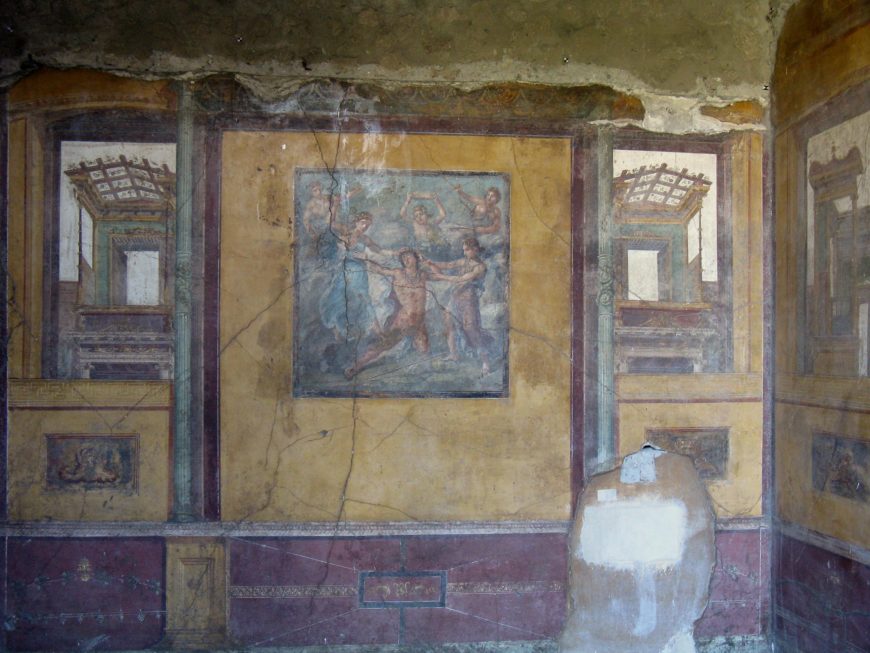
4th style wall paintings (from a room off the peristyle), Business firm of the Vettii, Pompeii (photo: Lady Erin, CC By-NC-ND 2.0)
Overview
The House of the Vettii or Casa dei Vettii (VI fifteen,1) is a Roman townhouse (domus) located inside the ruined ancient metropolis of Pompeii, Italian republic. A volcanic eruption destroyed Pompeii in the year 79 C.E., thus preserving extraordinary archaeological remains of the Roman town as it was at the time of its cataclysmic devastation. Those remains constitute a almost unparalleled resource for the written report of the Roman world.
Domus compages
Beginning with the Renaissance involvement in all things classical, architectural historians and archaeologists accept been debating the form and office of ancient Roman houses for several hundred years. The involvement in the domestic architectural form was fueled further past the re-discovery, in the middle of the eighteenth century, of Pompeii, Herculaneum, and other sites destroyed by Vesuvius.
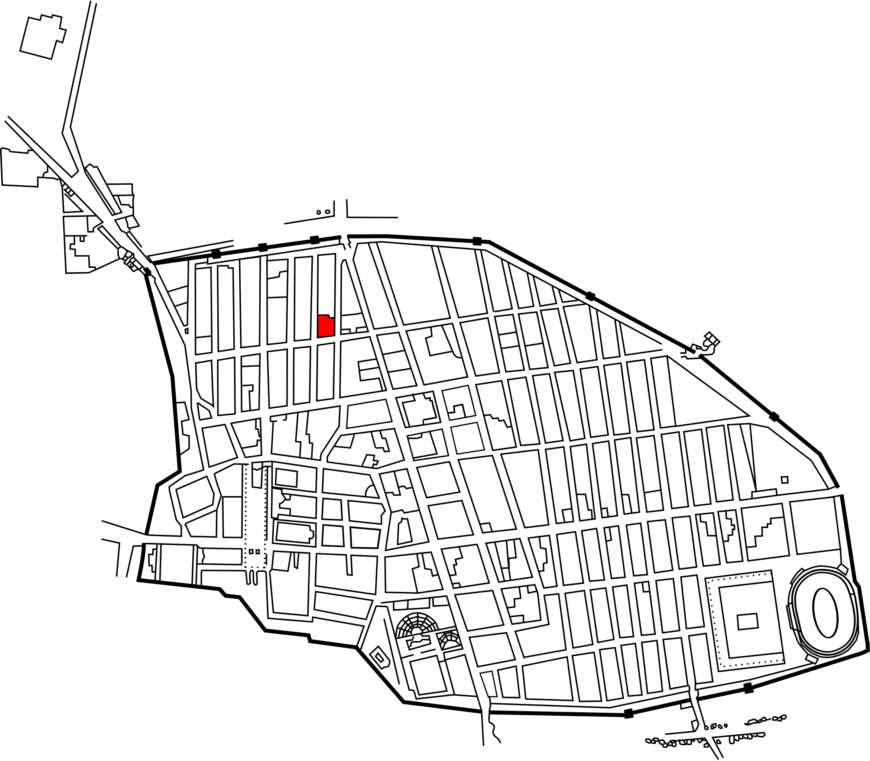
Program of Pompeii, with location of the House of the Vettii in red (by: MaxViol, CC BY-SA 3.0)
A house is, of course, a domicile—but information technology is too a stage on which the rituals of daily life and social hierarchy would be performed. During the time of the Roman democracy (fifth through first centuries B.C.E.), ranking aristocratic families (patricians) used domestic display as a way to reinforce social position and as a style to advance their own fortunes, as well as those of their dependents and clients (clientes), inside the community. Since Republican society operated on the basis of this patron-client relationship, the domus played a fundamental part in the reinforcement of social hierarchy as the patron (patronus) would receive his clients (clientes) in the atrium of his domus each concern day. While visiting with the patron, each client would get an eyeful of the patron's household wealth, thus applying implicit force per unit area on the patron to ensure that his house was tasteful and fashionable.
The patron-client organization revolved around asymmetrical social relationships whereby lower ranking clients were jump to their patrons by the qualities of trust (fides) and dutifulness (pietas). Governed by ancestral custom (mos maiorum), clients would seek back up and favors from the patron; in plow the patron provided protection, support, and benefaction, collectively known as patrocinium. This system had changed somewhat by the time of the brothers Vettii and information technology is unclear to what extent the patron-client organization factored in their lives or in their ain domestic sphere.
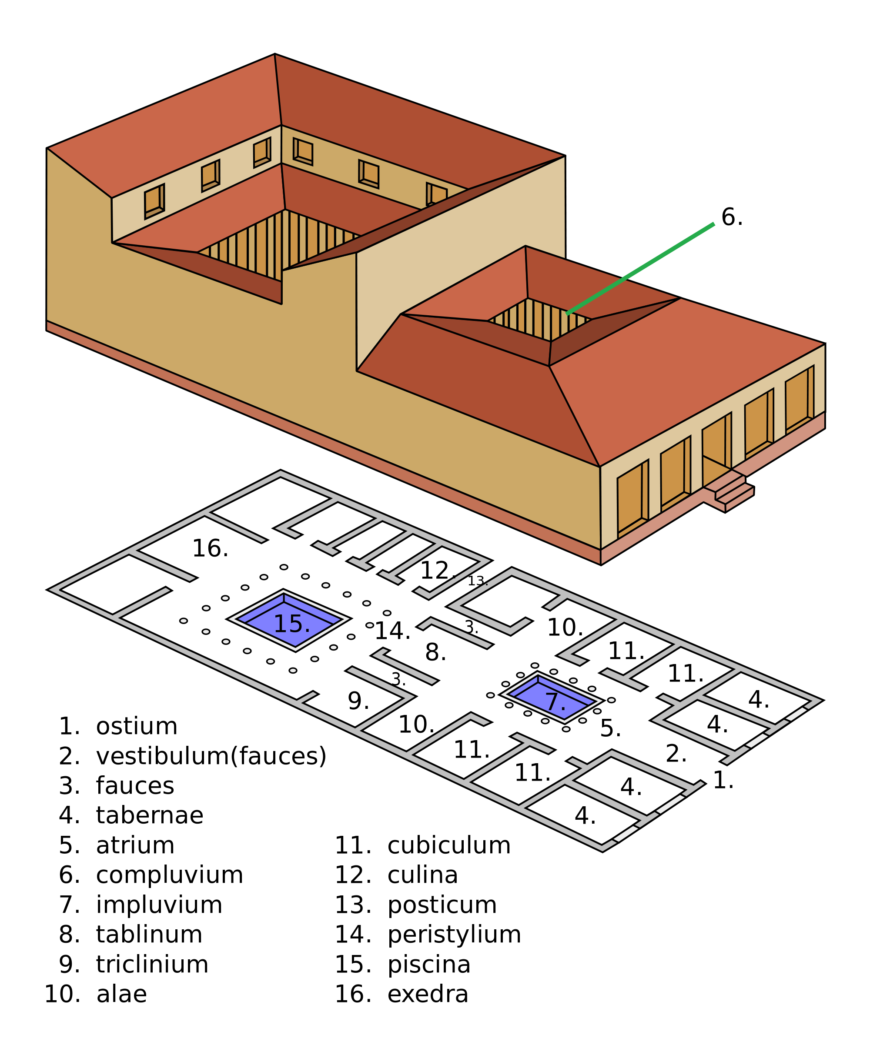
Standard plan of an ancient Roman Domus
In his treatise on Roman architecture, the offset century B.C.East. author Vitruvius outlines the cardinal elements, proportions, and aesthetics of the Roman house, creating what has been treated as a canonical recommendation for domestic architecture of the period. The Vitruvian catechism (or standard) proposes a range of plans, suggesting strongly that the organization of interior space was important in Roman architectural theory (De Architectura vi.3.3-6). Although the plan of the Roman domus does reflect the canonical aspects described by Vitruvius, we as well meet enormous variation with modifications and remodeling undertaken over fourth dimension.
The standard house (domus) plan has several cardinal architectural elements. More often than not entered from the street via a narrow doorway (fauces), the large centralized reception hall (atrium) is flanked past wings (alae) and frequently bounded by bedrooms (cubicula). The role of the head of household (paterfamilias), known equally the tablinum, links the public part of the house (pars urbana) to the private part of the house (pars rustica). This latter expanse frequently focuses on an open, colonnaded courtyard (peristylium) and serves as the middle of family life, with the kitchen (culina), dining room(south) (triclinium or oecus), and often a small garden (hortus). Many houses also had a second level that may have contained additional sleeping spaces and perhaps storage.
Excavation and identification
The House of the Vettii was excavated between late 1894 and early on 1896. The artifacts that were recovered allowed for the identification of the house's putative owners, Aulus Vettius Conviva and his brother, Aulus Vettius Restitutus. Both men have been identified equally former slaves or freedmen (liberti). The Vettii had risen to some prominence; Conviva was an augustalis—the top civic part for which a freedman would be eligible. In the construction and decoration of their house the brothers display a mind-set not uncommon among the newly-rich. Two strongboxes (arca—substantially lockable boxes for storing valuables), concrete signs of wealth, were placed prominently in the big atrium and so that visitors would exist sure to detect them.
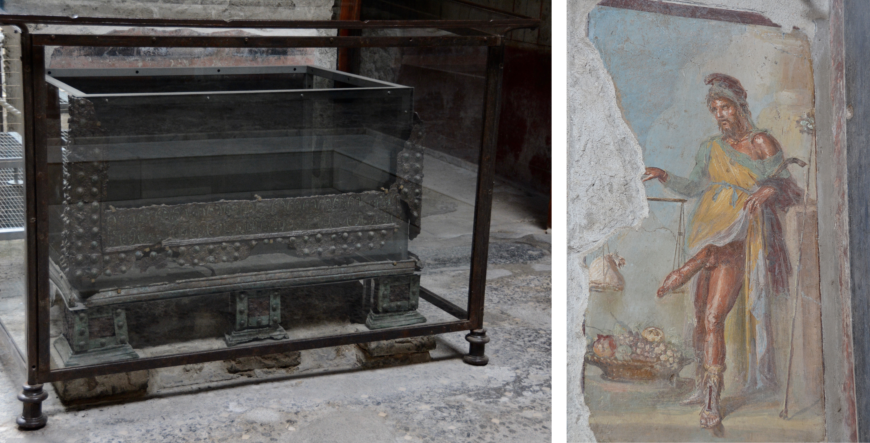
Left: Strongbox, Business firm of the Vettii, Pompeii (photo: Dr Sophie Hay); right: Priapus fresco (detail), Business firm of the Vettii, Pompeii (photo: Carole Raddato, CC By-SA two.0)
The strongboxes, paired with a painting of the god Priapus in the anteroom, serve to underscore the wealth of the brothers Vettii. This painting, which shows Priapus weighing his ain phallus against a bag of money, may represent the socio-economic ambitions of the Vettii and perhaps indicates that those ambitions were different from those of high-ranking citizen families. This is interesting when we consider that achieving the status of augustalis likely indicates that Conviva made a big donation to a public works project in Pompeii.
The plan of the house
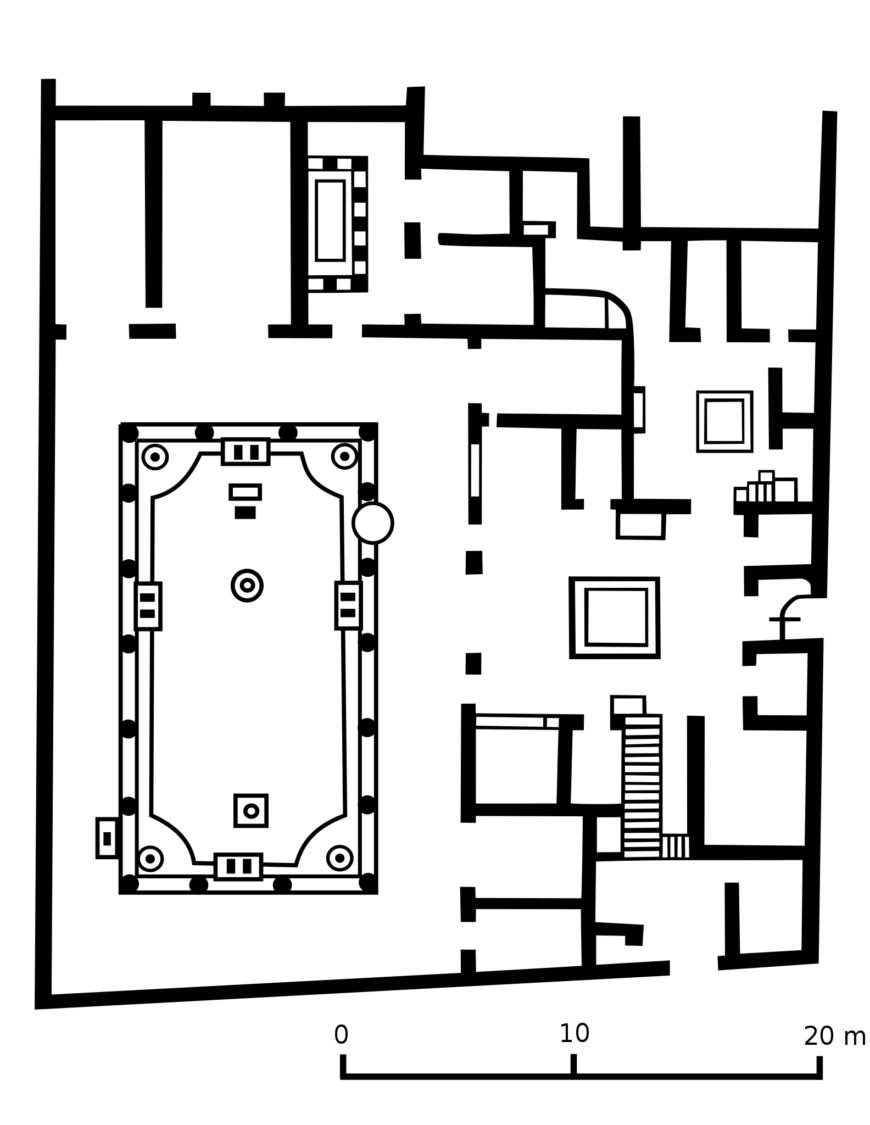
Plan, Firm of the Vettii, Belatedly Republican-Early Imperial domus, destroyed 79 C.E.
The House of the Vettii covers an area of approximately 1,100 square meters. The construction of the business firm and its decorations vest to the final period of Pompeii's occupation and therefore provides important evidence of the aesthetics of the urban center on the eve of its destruction.
The house was built atop the remains of an earlier house that survives, in office, in the form of the wings ( alae ) and a doorway. The program of the Business firm of the Vettii has two big central halls ( atria ) and, significantly, lacks an office space ( tablinum ). Entry to the firm was gained from the east by way of a vestibule that granted access to the larger atrium. The stone-lined bowl for collecting rainwater ( impluvium ) lies at the center of the atrium. This larger atrium communicates straight with the peristyle (an open courtyard surrounded by fluted Doric columns) by means of a set of folding doors. The smaller atrium was the focus of the service portion of the house, while the peristyle and its well-appointed rooms was meant for entertainment and dining.
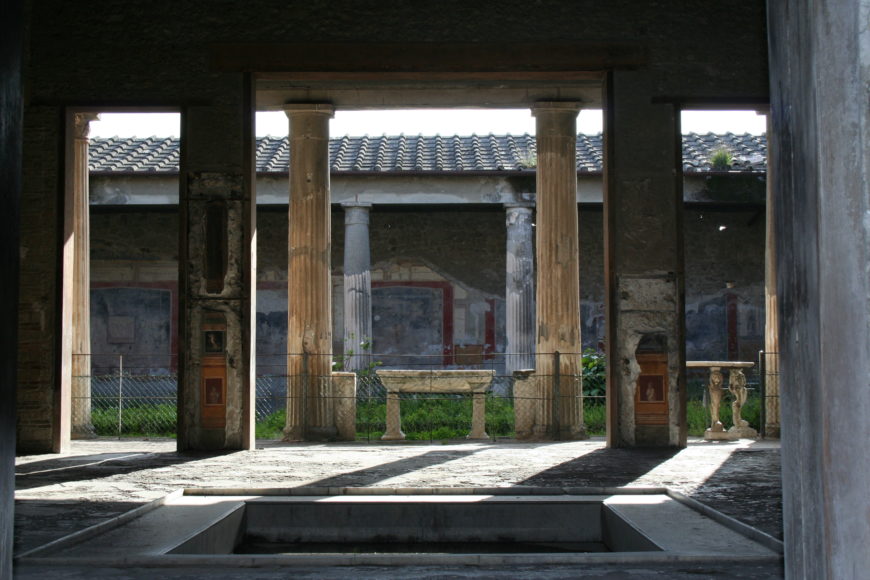
View through atrium to the peristyle (photograph: Peter Stewart, CC Past-NC 2.0)
Wall paintings
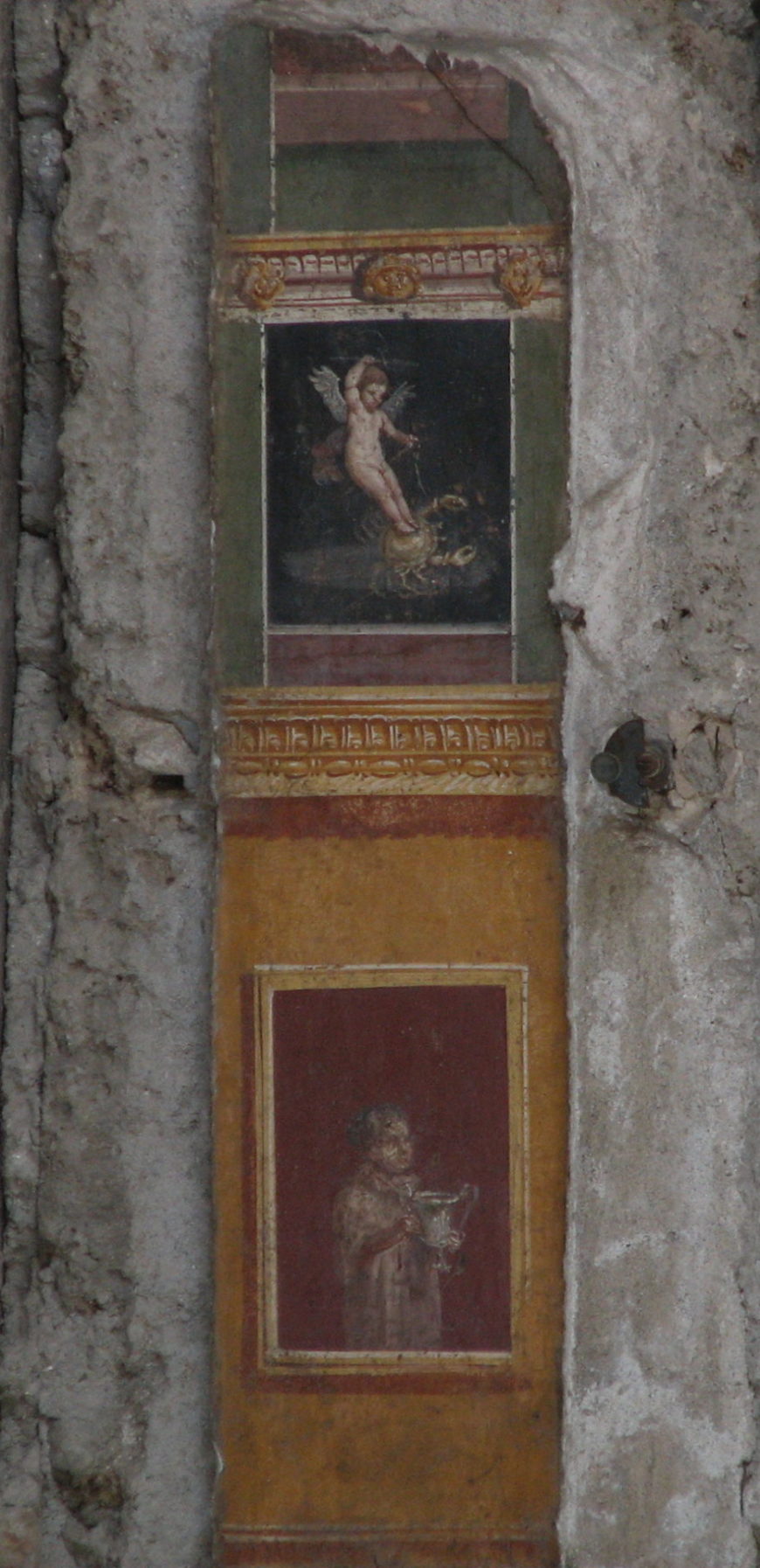
Frescoes in the atrium, Business firm of the Vettii, Pompeii (photo: Irene Norman, CC BY-NC two.0)
The decorative schema of the House of the Vettii provides important evidence for trends in domestic ornament in the final years of Pompeii'due south occupation. Since Pompeii suffered a major earthquake in 62 C.E. that caused significant destruction, the chronology of the wall paintings and other decorations in the House of the Vettii has been a topic of debate since the house's discovery.
Most art historians bespeak to the house's decorative schema every bit being representative of a key transitional phase, between the Tertiary and Fourth styles of Pompeian wall painting. Some scholars consider it among the finest examples of the 4th Style at Pompeii. Paul Zanker sees the Quaternary Style wall paintings every bit being imitations of higher art forms, reckoning that the called pictures aim to plough the rooms into picture galleries (pinacothecae).
The atrium is richly decorated, every bit are the rooms opening onto the peristyle. Two of these were in the class of existence painted at the fourth dimension of devastation, while the other iii are richly appointed with Fourth Style wall painting. The largest of these, a dining room, is decorated in panels of red and black with an exceptionally fine motif of erotes or putti (mythological winged gods associated with dear) engaged in various occupations (prototype below). The central panel pictures that were probable fix into the walls do non survive. Overall the scheme of wall painting in the house of the Vettii suggests an effort at forward-looking interior decoration on the role of the owners.
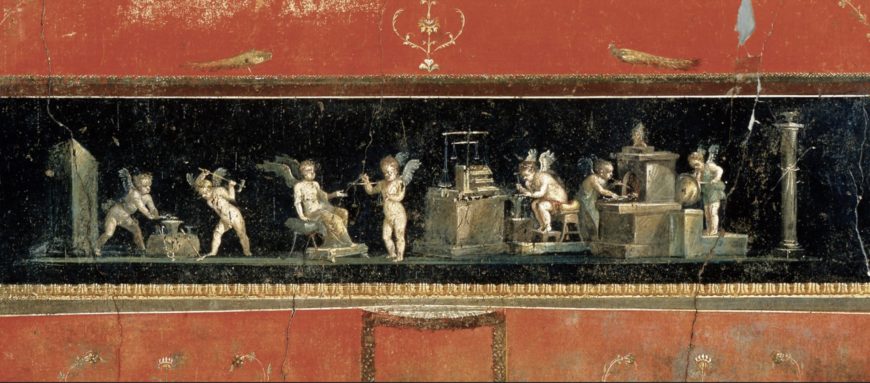
Putti fresco (detail), House of the Vettii, Pompeii (photo: Nora Garibotti)
Overall the prove furnished past the Firm of the Vettii offers key insights into domestic architecture and interior decoration in the concluding days of the city of Pompeii. The house itself is architecturally significant not only because of its size but as well because of the indications information technology gives of of import changes that were underway in the pattern of Roman houses during the third quarter of the first century C.East.
Additional Resources:
MIT resource
Roman Painting on the Heilbrunn Timeline of Fine art History
Archer, W. C. 1990. "The paintings in the alae of the Casa dei Vettii and the definition of the Fourth Pompeian style." American Journal of Archaeology 94.one:95-123.
Bergmann, B. 1994. "The Roman House equally Retentivity Theater: The Business firm of the Tragic Poet in Pompeii." The Art Message 76.two:225-256.
Clarke, J. R. 1991. The Houses of Roman Italy, 100 B.C.-A.D. 250: ritual, infinite, and decoration. Berkeley: Academy of California Printing.
Ling, R. 1991. Roman Painting. Cambridge: Cambridge Academy Press.
Richardson, Jr. Fifty. 1988. Pompeii: An Architectural History. Baltimore: Johns Hopkins Academy Press.
Sewell, J. 2010. The germination of Roman urbanism, 338-200 B.C.: between contemporary foreign influence and Roman tradition. (Periodical of Roman archeology Supplementary series; 79). Portsmouth RI: Journal of Roman Archaeology.
Sogliano, A. 1898. "La Casa dei Vetti in Pompei." Monumenti Antichi eight:234-387.
Trevelyan, R. 1976. The Shadow of Vesuvius: Pompeii AD 79. London: The Page Society.
Wallace-Hadrill, A. 1988. "The Social Structure of the Roman House." Papers of the British School at Rome 56:43–97.
Wallace-Hadrill, A. 1996. Houses and Society in Pompeii and Herculaneum. Princeton: Princeton Academy Press.
Zanker, P. 1998. Pompeii: Public and Private Life. Trans. D. L. Schneider. Cambridge, Mass.: Harvard University Press.
Smarthistory images for teaching and learning:
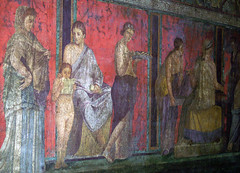


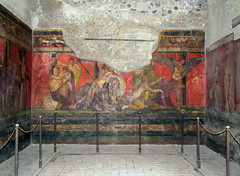










More than Smarthistory images…
Source: https://smarthistory.org/pompeii-house-of-the-vettii/
0 Response to "House of Vettii House of Vettii Ap Art History"
Post a Comment